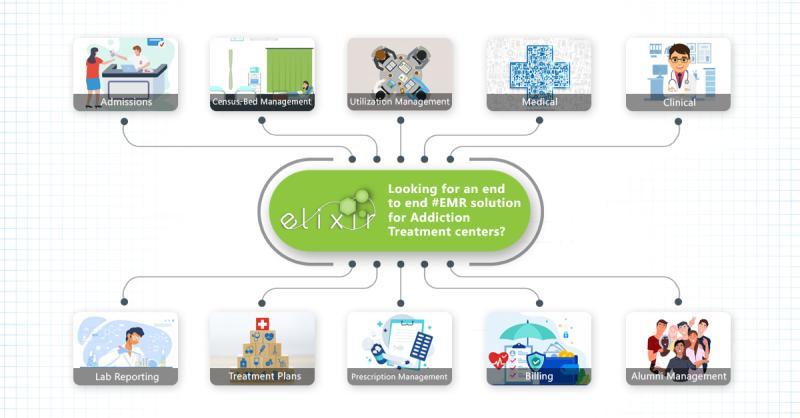Artificial Intelligence in Healthcare Sector
Introduction to Healthcare Sector
The Healthcare sector is the backbone of any country as the foundation of great nations is always laid on a healthy society/citizens. In recent times the unprecedented pressure faced by the healthcare sector is increasing due to population explosion, demographic variance, need of skilled workforce, and changing patterns of diseases. As we are facing a different level of catastrophe in the face of COVID 19, healthcare is forced to fill up the given gaps in its structure.
The thought of Artificial intelligence in healthcare goes way back to 1960-70 when AI systems like Dendral and MYCIN were born. These systems were designed specifically for organic chemistry and to identify different bacteria and related hypothesis. These problem-solving programs laid the foundation for a broader approach of artificial intelligence in health care through diagnosis, administrative services, patient care, and even inventory and supply chain management. AI alongside its forms like machine learning is being increasingly utilized in the healthcare industry thanks to its potential to rework the management, care, and satisfaction of patients within the hospital.
Artificial Intelligence and Healthcare Sector
Artificial intelligence in healthcare is supposed to be used through complex programing to imitate human intelligence for better analysis and implementation of complicated medical data. The base of AI which is human cognitive imitation gives it an edge for penetration in various healthcare sector needs. Artificial intelligence can be used from the initial point of instigation of a patient in the system to diagnose the patients through chatbots, from catering to medical needs through telemedicine to robotic practices in critical care units. The wider reach of Artificial intelligence is due to different applications as well as the form of Artificial intelligence available.

Types of Artificial Intelligence in Healthcare sector
Machine Learning:
Machine learning can be explained as computer algorithms that improve automatically through continuous exposure to a situation. It is a subset of Artificial intelligence which is based on the mathematical model of sample data to learn, train, and interpret a specific condition/model. Machine learning is being used in various medical diagnostic software, to begin with, and further attempts are going on to improve the predictive technology for diseases and diagnosis.
Neural Network:
This is a complex technological form of Artificial Intelligence where computing systems are vaguely designed as per biological neural networks. Neural network is designed for unsupervised learning within the system where the system learns and predicts without being programmed for specific tasks. The breakthrough in the Neural network is helping healthcare in predictive analysis of disease and patients through various data inputs like health conditions.
Deep Learning:
Deep learning is based on machine learning aspects based on artificial learning with a focus on representation learning through supervised or unsupervised learning. In healthcare, Deep learning helps in recognition through video, image, and speech and analyses the information for the smallest of diagnosis skipped by a human.
Natural Language Processing:
Natural language processing is based on the linguistic approach to learn and analyze interactions between computers and human language. It helps in churning large amounts of natural language data for machine translation of a given subject or situation. Natural language processing helps the healthcare sector in statistical methods to analyze and classify tons of clinical data on a regular basis.
Robotics:
Robotics branch of artificial intelligence is in use since 1985 in forms of scrub nurses and assistance through voices. In recent times we have seen increased participation of robotic surgery due to ease of complex tasks as well as simultaneous data analysis for further actions in surgery and aftercare.
Use of Artificial Intelligence in Healthcare sector
Artificial intelligence is used in healthcare for three classical medical practice of the diagnosis, prognosis, and therapy, and these are catered through artificial intelligence ability to gain information, process it, and give a well-defined output to the end-user. The primary aim of artificial intelligence is to provide tools to the healthcare sector workforce an additional hand in processing the in-hand data and providing alternated through predictions. As artificial intelligence is gaining in the road to unreached variables of the healthcare sector, let us take a look at the roles it played in various support systems
Administrative Support
The recent development in the healthcare sector is also conditioned with an influx of patients and an increase in overall demands. The utilization of artificial intelligence is directly related to these factors and hence acted as a mandatory application for the healthcare sector.
1. Artificial intelligence plays a role in maintaining the patient’s introduction in the system by handling the related data for doctor and administration use. The scheduling programs for the patient come in handy when the establishment is big in nature and the workforce can be utilized elsewhere.
2. Artificial intelligence-powered chatbots are used to interact with patients and are useful tools to gather initial diagnostics of a patient. This technology is also used for the aftercare of patients in terms of critical surgery or life-threatening diseases.
3. Machine learning and artificial technology also used for matching data for insurance claim settlements It helps in recognizing data types to shorten the claim settlements and audit the given data for further use.
Electronic health records and Electronic medical records
As data is an important factor for the patient cycle, artificial intelligence is contributing to electronic health records and electronic medical records. The technological introduction has improved the data collection method and helped in the diagnosis of a patient. The patient data is classified in two important versions i.e. Electronic Health Record (HER) and Electronic Medical Record (EMR), the basic difference between two was distinguished in recent times only. The electronic health record (EHR) is a more observational collection of the electronic health information of individual patients. The EMR, in contrast, is the patient record entered by providers for specific procedures in hospitals and related environments, which can serve as a data source for an EHR.
Compared to the traditional method of data collection, artificial intelligence gives a safe and easy to use environment when it comes to data collection. The data collected through these means is more reliable due to the introduction of various machine learning processes like the natural language process. The natural language process uses voice recognition for capturing data hence giving doctors freedom for more patient-related procedures.
Artificial learning and machine learning help the healthcare sector to compile EHR and EMR from various sources into one meaningful set of data. This data is used in the ongoing patient cycle for diagnosis and medicinal applications as well as for the future prospects of data interpretations of disease. Countries like Australia, the United Kingdom, and the United States have introduced EMR systems in ambulances also. The introduction of EMR facilities helped the hospitals inpatient data sharing in a real-time manner, better treatment of the patient in critical cases, to develop training methods for paramedical resources, and data-based future treatment options.
Artificial Intelligence in the critical care unit
In an intensive care unit, the artificial intelligence acts as a catalyst which maintains the workload between healthcare professionals and the machine. Usage of artificial intelligence helps in optimizing the workload of nurses and doctors so that the point of focus should be patient rather than technical and paperwork. Artificial intelligence equipped machines take over the data collection/analysis part as well as patient monitoring on a real-time basis.
Critical care units are now equipped with light sensors, sound sensors, and digital monitoring systems for a real-time check up on the admitted patients. This not only helps the doctor to monitor the patient conditions, but the data collected through systems can be updated in EMR for future treatment decisions.
Along with monitoring systems in healthcare sectors, artificial intelligence is also helping out in robot-assisted surgeries. In this case, the doctor uses tele manipulator to conduct surgery through robotic arms, which provides more precision in terms of tools and also gives the option of remote surgery.
Due to robotic artificial intelligence use, the surgery is done with precision, smaller incisions, decreased blood loss, and quicker healing time. The difference between the traditional methods and robotic use is of three-dimensional magnification of subject which helps in better reach in critical surgeries. Artificial intelligence use in surgeries has resulted in reduced duration of hospital stays, blood loss, transfusions, and use of pain medication.
Inventory and supply chain management
Inventory and supply chain is an important and neglected part of the healthcare sector. For long this branch of healthcare sector was belittled in terms of innovation and workmen related operations. The inventory and supply chain management are as needed as front line workforce just due to the fact the medicine stocks are well prepared at any given point. Artificial intelligence has made a breakthrough in this support system by providing managed data facility through barcodes system and alerts on various levels for stocks/supplies. Artificial intelligence not only provides in house medicines details on a real-time basis but also permits the flow of information between supply chain parties like investors, manufacturers, and suppliers. Inventory monitoring with the elimination of manual processes helps the workforce to indulge in other productive processes. Artificial intelligence also provides robotic automation checking, fulfilling, and restocking inventory as well as provides stock forecasting through data mining solutions.
Elixir as a tool for the Healthcare sector
Salesforce has worked on introducing artificial intelligence through its health cloud. The thought process behind the health cloud was to tap the opportunities of automation in health care sectors and provide relief from manual work to the already strained workforce. To implement Artificial Intelligence in healthcare right now, the biggest challenge is tapping quality data and giving it as an input to the system. In other words, for Artificial Intelligence to work, we need big data, streaming from all your systems at once. That is where the role of having an integrated system comes into play.
Elixir is an EHR built-in salesforce to exactly do that. Elixir is an end to end EHR that has a powerful blend of CRM, EMR, and RCM which is built on top of Salesforce, integrating the health cloud, sales cloud, marketing cloud, and Salesforce Einstein. The integration of the Salesforce clouds provides the most robust and customizable application which is a one-stop solution for all the functional needs. Meanwhile, it taps into every bit of information from all the systems put together which unlocks the true potential of any Artificial Intelligence system.
Elixir captures overall patient history in the form of EMR and EHR which is available through systems to every concerned party involved and that is one of the functional capabilities of Elixir. Through Elixir we provide following functionalities as a product

Artificial Intelligence is already playing crucial roles in our day to day work management through various tools. The healthcare sector is also adopting the same in a steady manner for solving a large array of clinical problems. In regards to collecting data of patients and diseases, we have come a long way where we can predict the disease spread and can use the data for future pandemics.
In the current scenario where artificial intelligence is used to find drugs for COVID 19 but also predicted the spread rate of the pandemic. The artificial intelligence not only forecasted the spread of diseases but also helped the healthcare sector to determine the structure of the virus. The neural network usage to determine the signs of COVID 19 symptoms was a breakthrough in this pandemic. The machine learning is working on large genomic datasets for future prevention of this level pandemics
We have seen the success of IBM Watson in this regard where ample time and money were able to oversee the artificial intelligence foothold in healthcare sectors. Introduction of Microsoft Hanover project and Googles Deepmind platform for the healthcare sector is a huge boost towards artificial intelligence. We do foresee a future where artificial intelligence will complement health workers’ efforts to deliver healthcare facilities efficiently and independently.
Recent Posts
Does Your Healthcare Solution Comply with HIPAA Regulations?
Integrated PDMP to help physicians address the opioid crisis
Categories
Recent Comments
Archives
- March 2025
- February 2025
- November 2024
- July 2024
- April 2024
- February 2024
- November 2023
- September 2023
- August 2023
- February 2023
- January 2023
- July 2022
- April 2022
- March 2022
- February 2022
- January 2022
- December 2021
- November 2021
- October 2021
- September 2021
- March 2021
- December 2020
- November 2020
- October 2020
- May 2020


